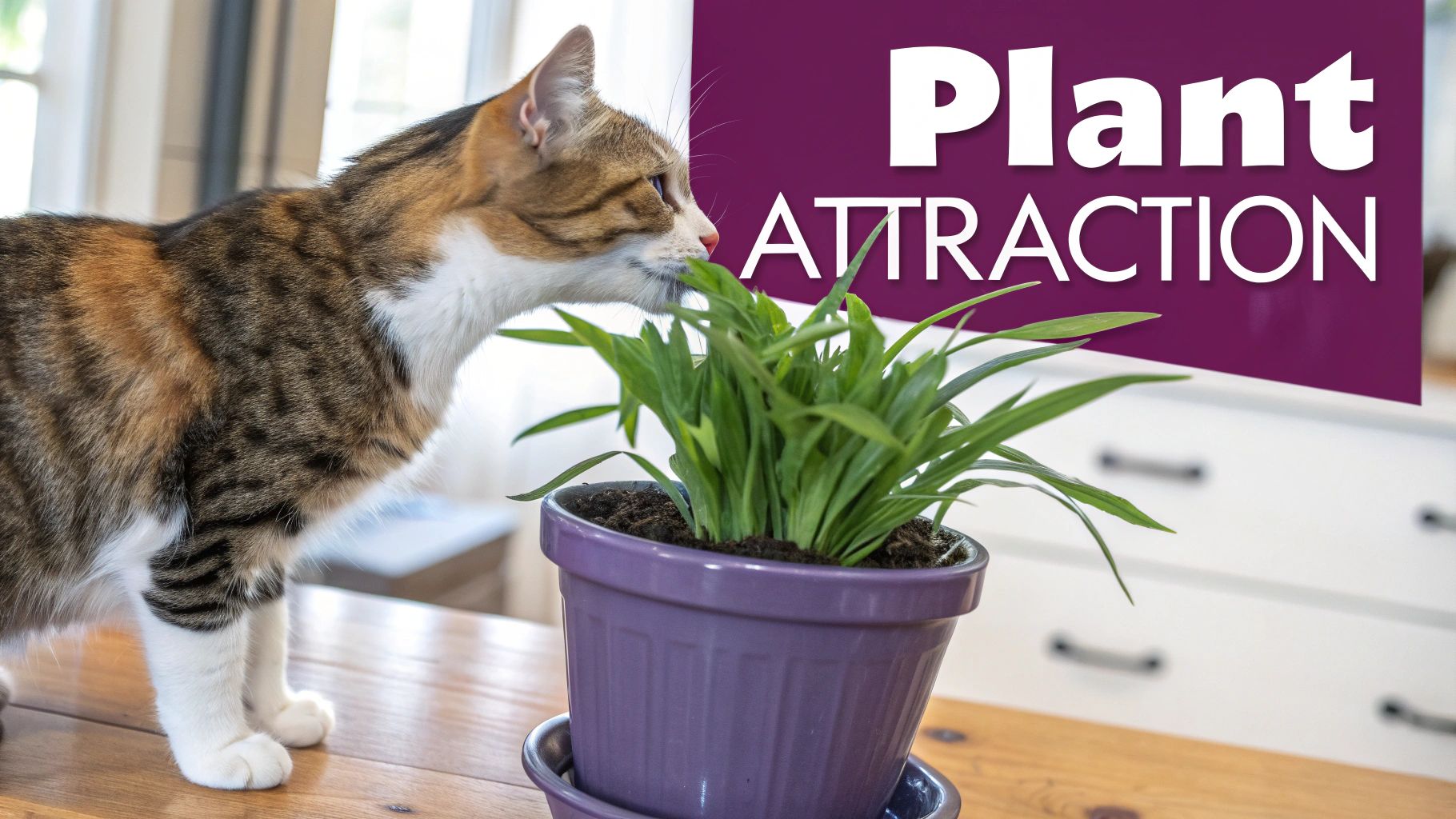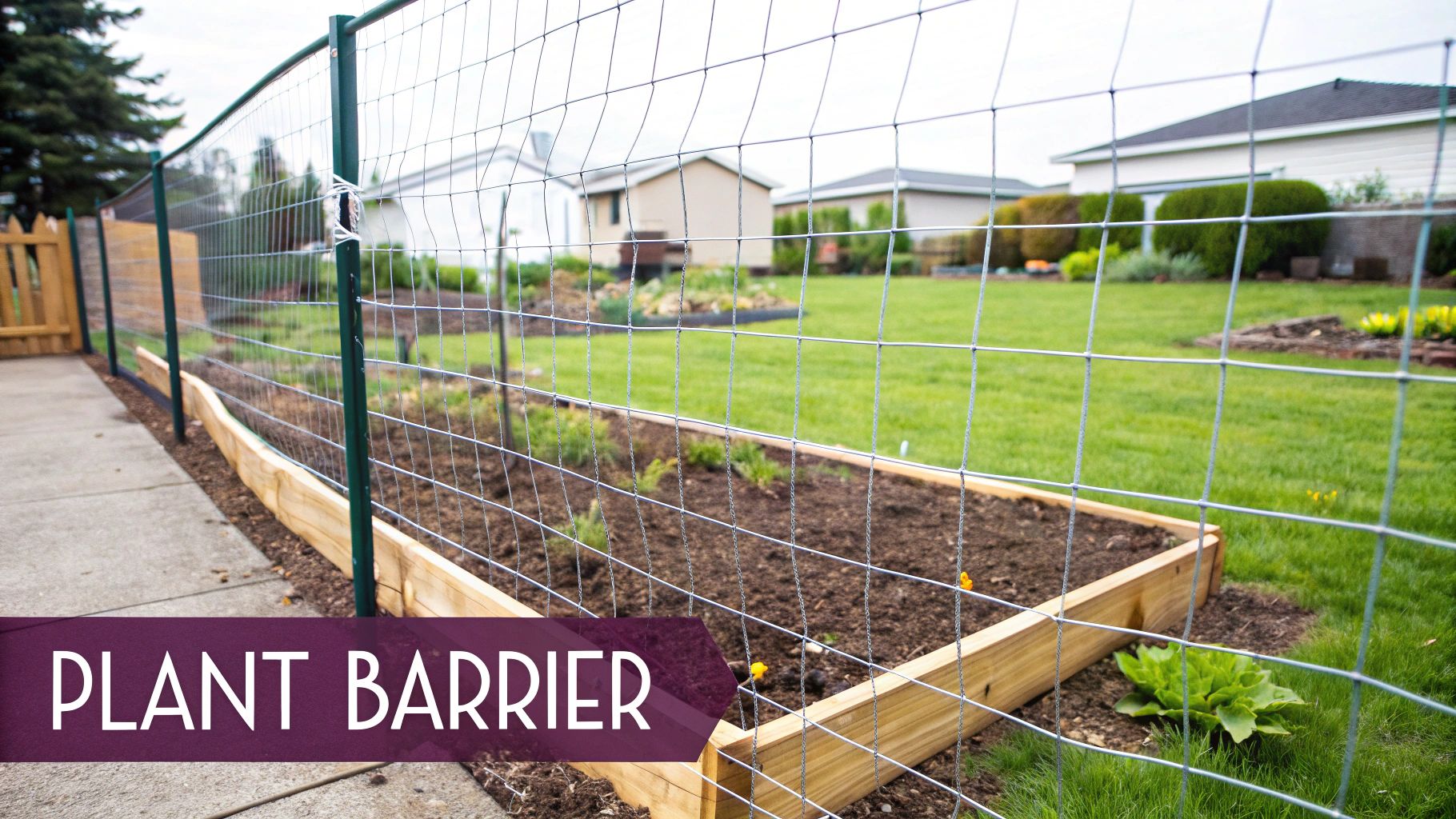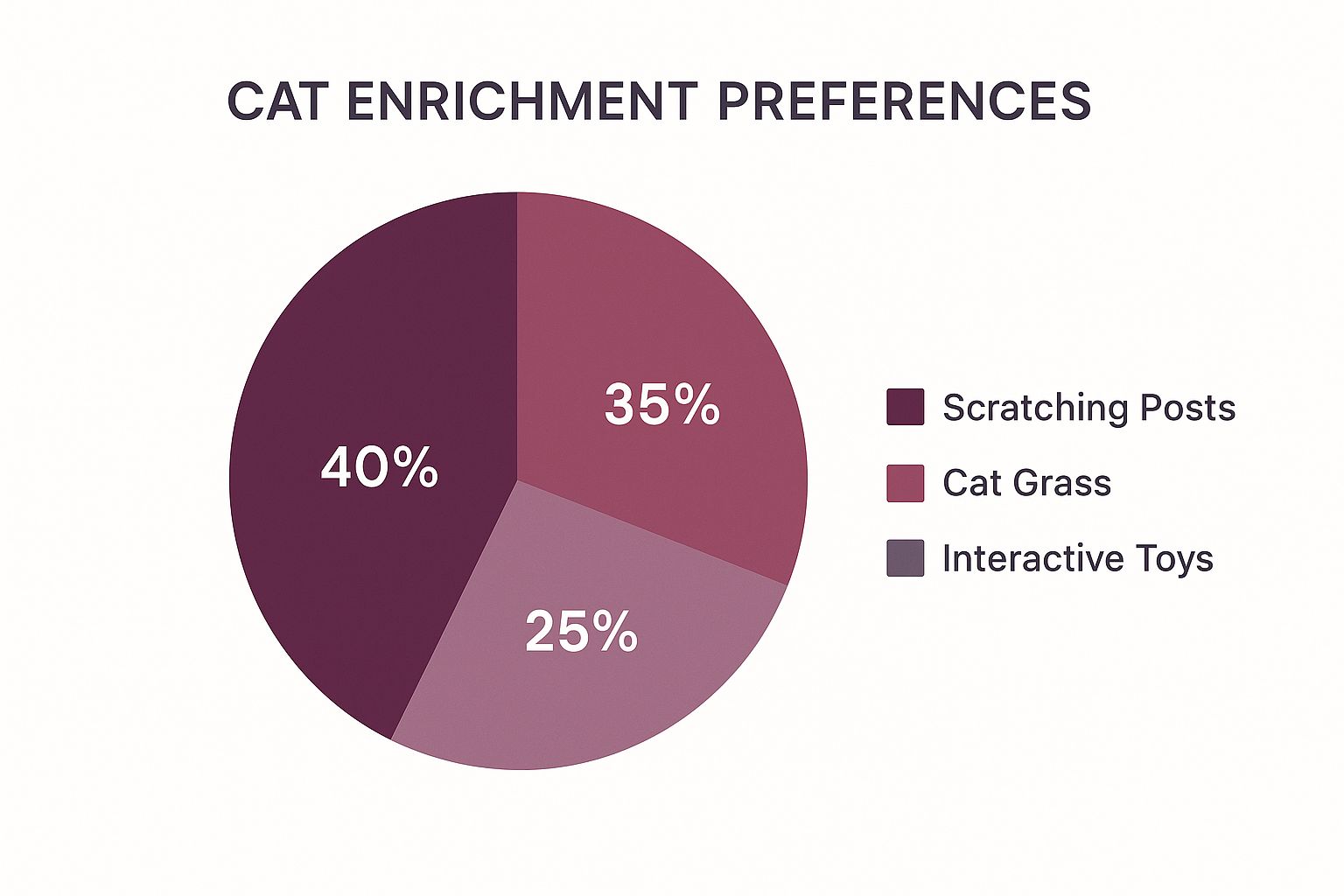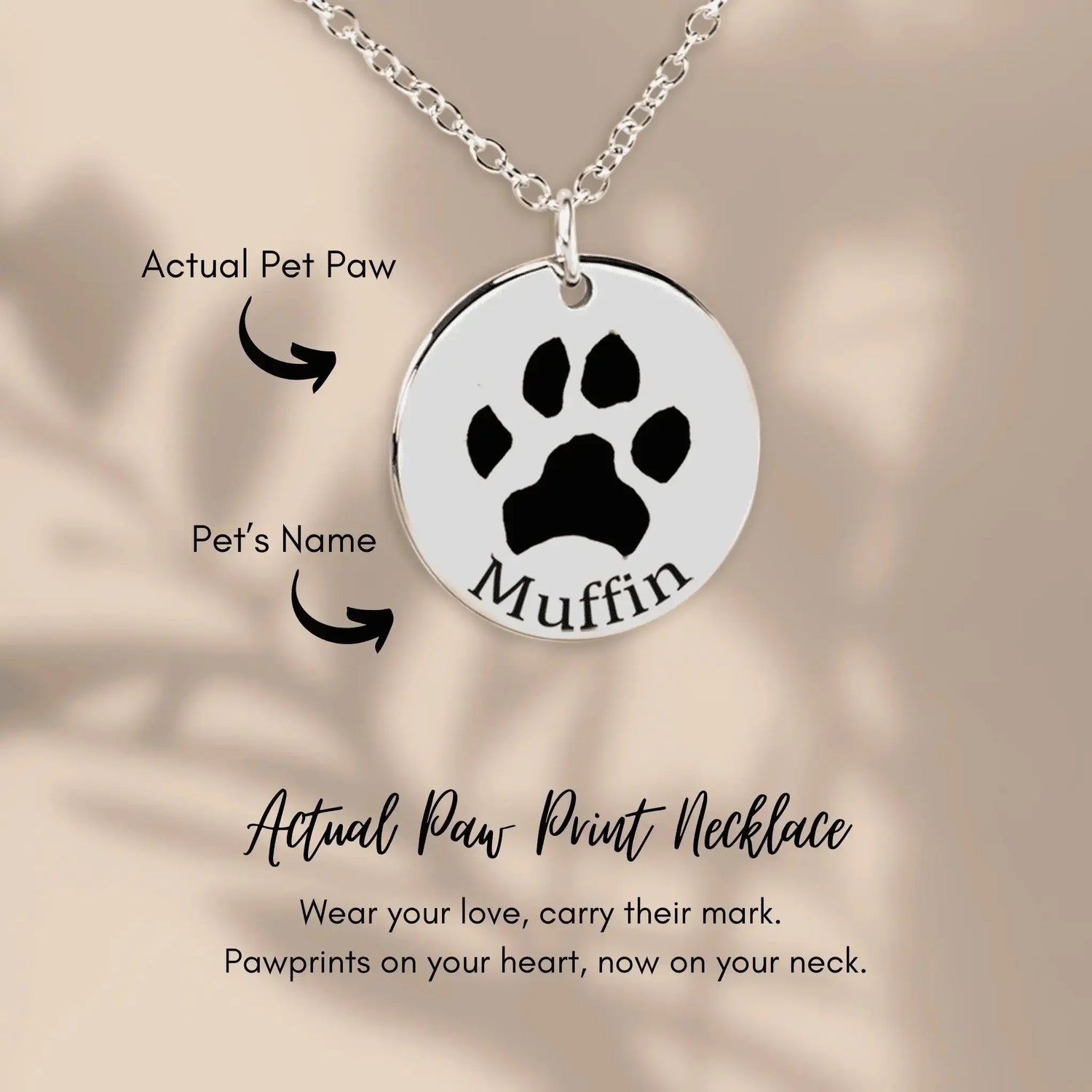How to Keep Cats Away from Plants: A Purrfect Guide 🐾

Keeping your cats away from your plants isn’t about a single trick—it's about creating a harmonious space with a mix of deterrents, smart environmental changes, and a little positive reinforcement. The goal is to gently redirect their natural instincts, not to punish them for being curious little explorers like our mascot, Floofie!
Why Your Cat Is Obsessed With Your Plants
So, you're a proud parent to both plants and cats? Welcome to the club! 🌿😼
If your living room has turned into a jungle gym where your Monstera is the star attraction, you are definitely not alone. One minute you have a beautiful, thriving fern, and the next, it’s a shredded salad bar for your feline overlord.
What's the deal?
Let’s get inside that mischievous little head. A cat's fascination with plants isn't just about being a furry agent of chaos; it's driven by pure, unadulterated instinct. Understanding why they do it is the first real step to creating a peaceful home for your green babies and your fur babies.
Decoding the Plant Attack
Why does it seem like our cats have a personal vendetta against our houseplants? The reasons are usually a cocktail of instinct, curiosity, and just a tiny bit of sass.
- Ultimate Boredom Busters: A dangling leaf? That's the best cat toy ever invented! For a bored kitty looking for some action, the movement and texture are simply irresistible.
- A Call of the Wild: For our indoor friends, chewing on fibrous materials is their way of mimicking how they'd munch on grass in the wild to help with digestion.
- The Texture is Terrific: That cool, soft soil can feel like the purrfect spot for a nap. Or, unfortunately, a makeshift litter box. 🙀
It's an incredibly common issue. In fact, some surveys show that 40 to 50 percent of cat owners have watched their cats nibble on or completely demolish their houseplants, a behavior that’s all thanks to these deep-seated instincts. You can dive deeper into the science behind it in this fascinating study on cat-plant interactions.

The Serious Side of a Nibble
While a little plant shredding might just seem like a messy inconvenience, it's so important to remember that many common houseplants are actually toxic to cats. A seemingly innocent chew on the wrong leaf can lead to serious health problems, from an upset stomach to much more severe consequences.
Floofie’s Tip 🐾: Never, ever assume a plant is safe! Always double-check the toxicity of any new plant you bring into your home. A quick search on the ASPCA’s plant list can literally be a lifesaver for your furry friend.
Understanding your cat's behavior isn't just about solving a mystery; it’s about learning to see the world through their eyes. This same curiosity drives all sorts of other adorable quirks. To learn more about their unique language, check out our guide on why cats show their belly.
Once we understand their motives, we can find compassionate and effective ways to keep both our cats and our plants safe and happy.
Let's start with a few quick wins you can implement right away.
Quick Guide to Creating a Cat-Safe Plant Zone
Here’s a quick-glance table to help you get started immediately. These are simple, effective strategies that address your cat’s natural instincts while protecting your plants.
| Strategy | Why It Works | Floofie's Tip 😺 |
|---|---|---|
| Use Citrus Peels | Cats hate the smell of citrus. Placing orange or lemon peels in the soil is a natural, non-toxic deterrent. | Refresh the peels every few days to keep the scent strong and effective! |
| Cover the Soil | Placing large, smooth stones or pinecones on top of the soil makes it an uncomfortable and unappealing spot for digging or napping. | Polished river rocks look great and do the job perfectly. Just make sure they're too big for your cat to swallow. |
| Provide a "Yes" Plant | Offer a pot of cat grass or catnip. This gives them a safe and appealing alternative to chew on. | Place their special plant near one of their favorite hangout spots to encourage them to use it instead of your prized pothos. |
| Make Plants Inaccessible | Use hanging planters, high shelves, or place plants in a room your cat can't access. | A pretty macrame hanger can be a stylish lifesaver for both your plant and your sanity. |
Think of this as your starter kit. By combining a few of these simple ideas, you're already on your way to creating a home where everyone—leafy or furry—can thrive together.
Ready to play a little psychological warfare with your feline plant terrorist? The goal is to make your plant areas an invisible no-go zone using scents and textures your cat finds completely unappealing. This is all about gentle persuasion, not punishment.
We’re simply making the plant less interesting than, say, a perfectly good sunbeam or an empty Amazon box. Let's dig into some easy, pet-safe DIY tricks to protect your green friends.
Using Scents Cats Can't Stand
A cat's nose is incredibly powerful, and we can absolutely use that to our advantage. Certain smells we find delightful are a huge turn-off for them. Think of it as building a "scent fence" around your prized monstera.
Citrus is the classic go-to. Cats are famously not fans of the sharp, zesty aroma of lemons, oranges, and other citrus fruits.
- DIY Citrus Spray: Just mix water with a few drops of lemon or orange essential oil in a spray bottle. Give the plant leaves a light misting. Always test it on a small leaf first to make sure your plant is okay with it!
- Citrus Peel Barrier: This one is even easier. Scatter some fresh orange or lemon peels on top of the soil. You'll need to swap them out every couple of days as they dry, but it's a simple and surprisingly effective method.
Another great option is coffee grounds. After your morning brew, sprinkle the used grounds over the soil in your pots. Not only do cats dislike the smell, but the grounds also add some nice nutrients to the soil. A total win-win!
Making Pots and Soil Uninviting
Sometimes it's not the leaves they're after, but the soft, diggable soil. It can look like the perfect private litter box or a cozy spot for a nap. The trick is to change the texture and make that prime real estate far less comfortable.
Floofie's Pro Tip 🐾: The key is making the surface bumpy, poky, or just plain weird for sensitive paws. If it's not a comfy spot to stand, they'll quickly move on to find a better place to lounge.
Try adding a layer of decorative (but secretly defensive!) materials right on top of the soil:
- Pinecones: They’re poky, awkward to step on, and look pretty rustic.
- River Stones: Large, smooth stones make digging impossible and give your pot a clean look.
- Seashells: They look beautiful and create a lumpy, uneven surface that paws don't like.
If you're looking for a ready-made solution, a lot of cat parents have amazing success with a good bitter apple spray. These sprays are totally safe for your pets and most plants, but they have a taste that cats find absolutely disgusting. It usually only takes one little taste-test for them to decide your plants are no longer on the menu.
Redesigning Your Space for Peaceful Coexistence
Sometimes, the best way to keep your cat away from your plants is to play a clever game of interior design Tetris. Let's be real, our fur babies are tiny, acrobatic geniuses. Our mascot Floofie sees a bookshelf not as a place for books, but as a staircase to adventure! 😼
By strategically rethinking your space, you can create a beautiful home where your plants and your cat don't just survive, but actually thrive together.
The secret? Think vertical! Cats are natural climbers, and we can use their love for high places against them (in the nicest way, of course). Elevating your plants is one of the most effective ways to put them safely out of paw’s reach. This isn't just a practical solution; it's a chance to add some serious style to your home.

Go High to Keep Paws Low
Let's get those green babies off the ground. When you lift your plants, you remove the temptation from your cat's direct line of sight. Out of sight, out of mind... mostly!
- Hanging Planters: These are a total game-changer. A stylish macrame hanging planter not only saves your fern from becoming a snack but also adds a chic, bohemian vibe to any room. Just make sure to hang it far enough from shelves or furniture that your cat could use as a launchpad.
- High Shelving: Install some floating shelves high up on a wall specifically for your plant collection. This creates a stunning green feature wall that your kitty can admire from below without being able to reach.
- Tall Plant Stands: Not all stands are created equal. You'll want to opt for heavy, stable plant stands that have a narrow top. A wide, solid base makes it much more difficult for even the most determined cat to topple over.
Floofie’s Design Tip 🐾: Remember, a wobbly shelf is an open invitation for a cat-tastrophe! Always make sure any high-up plant displays are securely anchored to the wall. Safety first—for both your plants and your paws!
Creating Stylish Barriers
If going vertical isn't really an option in your space, you can create physical barriers that are both effective and aesthetically pleasing. The goal is to make the plant inaccessible without turning your home into a fortress.
For instance, an elegant enclosed glass terrarium can house delicate succulents or air plants. This turns them into a living work of art that’s completely cat-proof.
Another fantastic idea is to group plants together behind a decorative screen or even inside a large, open-air birdcage for a unique, vintage look. This keeps curious noses out while still allowing for plenty of light and air circulation.
Of course, if your cat is a dedicated climber, giving them their own approved structure is a brilliant way to redirect that energy. For some great inspiration, you can learn how to build a DIY cardboard cat tower they’ll love way more than your ficus.
Redirecting Kitty Instincts with Positive Outlets
It's time to get inside your cat's brilliantly mischievous mind. Instead of just playing defense with deterrents and barriers, let’s go on the offense with some irresistible distractions. This isn't about scolding them for chewing on a plant; it's about giving them an enthusiastic "YES!" to something way more fun. 😼
The real secret to keeping cats away from plants often lies in redirection. By working with their natural instincts for chewing, scratching, and playing, you can guide them toward better choices. Our mascot Floofie agrees—a well-placed catnip mouse is way more exciting than a boring fern leaf!
The goal here is to provide such appealing outlets for their energy that your houseplants become yesterday's news.
Give Them a Garden of Their Own
If your kitty is determined to munch on something green and leafy, why not give them their very own salad bar? Offering a cat-safe plant is a fantastic way to satisfy their craving without sacrificing your prized pothos.
- Cat Grass: This is the holy grail for plant-chewing cats. Usually a mix of rye, barley, or wheatgrass, cat grass is packed with nutrients that can actually help their digestion.
- Catnip: The classic kitty favorite! A small pot of fresh catnip can provide hours of euphoric entertainment and a healthy outlet for their chewing habits.
Learning how to grow catnip grass for cats is an amazing strategy to redirect those chewing instincts for good. Just place their special pot in a sunny, accessible spot they love, and watch them choose their own garden over yours. It's a win-win for everyone!
Upgrade Their Toy Box
Sometimes, a plant attack is just a furry cry of boredom. A dangling leaf is the original cat toy, after all! If their environment isn't stimulating enough, they'll create their own fun—often at your plant's expense. The solution? Make their official playtime far more engaging than your greenery.
Floofie’s Golden Rule 🐾: A tired cat is a well-behaved cat. If you can channel their inner hunter with engaging play, they'll be too busy (and too sleepy) to bother your botanical buddies.
This is where interactive toys really shine. Puzzle feeders that make them work for treats, robotic mice that skitter across the floor, or a classic feather wand you control can satisfy their predatory drive in a positive way. To find the perfect boredom buster, explore our guide to the top interactive cat toys for indoor cats. A well-stocked toy chest is a powerful tool.
Gentle Training and Positive Reinforcement
You can also use gentle training techniques to set clear boundaries. This isn't about punishment; it's about clear communication in a language your cat understands.
If you catch your cat mid-munch, a sharp, sudden clap or a firm "Ah-ah!" is usually enough to interrupt the behavior without scaring them. The moment they move away from the plant, immediately redirect their attention to an approved toy or their cat grass.
When they start batting at their toy mouse instead, shower them with praise, pets, or a tasty treat. This immediate reward creates a positive association, teaching them that leaving plants alone = good things happen! Consistency is everything here, and over time, they’ll learn that their own toys are far more rewarding than your houseplants. ✨
Choosing Gorgeous Cat-Safe Houseplants
Let’s be honest, the absolute best way to stop cats from treating your plants like a salad bar is to choose greenery that’s completely safe for them in the first place. Forget the constant stress and worry—we can build a stunning indoor jungle where your kitty can roam freely and you can have total peace of mind.
This is all about creating a beautiful, safe haven where both your fur babies and your green babies can thrive together. Instead of a constant battle, you can fill your home with gorgeous, non-toxic options that make everyone happy.
Floofie-Approved Greenery For Your Home
You don't have to sacrifice style for safety! There's a whole world of stunning plants that won't harm a curious cat. Here are a few popular and easy-to-care-for favorites that get a big paws-up from us:
- Spider Plants (Chlorophytum comosum): These are fantastic air purifiers with fun, dangly "spiderettes." Your cat might find them endlessly entertaining, and they're totally safe to bat at.
- Calatheas (Prayer Plants): Known for their striking, patterned leaves that fold up at night, these plants add a touch of drama and are completely non-toxic.
- Boston Ferns (Nephrolepis exaltata): With their lush, feathery fronds, Boston Ferns are perfect for hanging baskets and are 100% kitty-safe.
- Haworthia: These small, striking succulents are a great alternative to potentially toxic aloe plants. If you're exploring the succulent world, look for the easiest succulents to grow indoors and then just double-check that your chosen variety is feline-friendly.
It's also a great idea to provide a safe alternative like cat grass to satisfy your kitty's natural urge to chew. Think of it as a peace offering.

This chart really puts it into perspective: giving your cat their own grass to munch on is nearly as popular an enrichment tool as a scratching post. That makes it a powerful way to redirect their attention from your prized monstera.
The Danger Zone: Plants To Avoid
While we all love adding new plants to our collection, some common beauties pose a serious threat to our feline friends. The risk is very real; veterinary data shows over 700 plant species are toxic to cats.
The most dangerous of all are lilies. Even a tiny amount of pollen licked off their fur can lead to acute kidney failure in cats. It's just not worth the risk.
Floofie’s Critical Warning 🐾: If you have a cat, you simply cannot have lilies in your home. This includes all types like Asiatic, Tiger, and Easter lilies. The risk is far too high for our precious companions.
Always steer clear of these common culprits:
- All Lilies (Lilium and Hemerocallis species): Extremely toxic and potentially fatal.
- Sago Palm (Cycas revoluta): Highly toxic, especially the seeds, and can cause liver failure.
- Dieffenbachia (Dumb Cane): Can cause intense oral irritation, swelling, and difficulty breathing.
- Philodendron: A very popular houseplant family, but its leaves contain crystals that are toxic to cats.
With so many plant options out there, it can be tricky to remember what's safe and what's not. Here's a quick reference guide to help you spot some common toxic plants and their safer look-alikes.
Cat-Safe vs. Toxic Plants: A Quick Reference Guide
| Safe Plant to Buy ✅ | Toxic Plant to Avoid ❌ | Potential Risk |
|---|---|---|
| Boston Fern | Asparagus Fern | Can cause skin irritation and gastrointestinal upset. |
| Christmas Cactus | Poinsettia | Causes mouth irritation and vomiting. |
| Haworthia | Aloe Vera | Can lead to vomiting, diarrhea, and lethargy. |
| Parlor Palm | Sago Palm | Extremely toxic; can cause liver failure and death. |
| Calathea (Prayer Plant) | Dieffenbachia (Dumb Cane) | Causes severe oral irritation and swelling. |
This table is a great starting point, but always do a quick search on a plant's toxicity before bringing it home.
By consciously choosing safe plants, you create a space that’s beautiful, vibrant, and—most importantly—a worry-free environment for the furry family members you love. Your cat and your plants can finally live in purrfect harmony! ✨
Your Cat and Plant Harmony FAQ

Still got a few questions bouncing around? Don't worry, Floofie and the team are here to help! 😼 We’ve pulled together some of the most common questions we hear from fellow plant and cat parents to help you create a truly peaceful home.
Let’s tackle these FAQs and get you the clear answers you need to keep your cats and plants living in harmony.
Why Did My Cat Suddenly Start Chewing My Plants?
It can be baffling when your perfectly behaved cat suddenly decides your fiddle-leaf fig is a chew toy. This new habit is almost always a signal that something else is going on in their world.
A few common culprits include:
- Boredom: Is your cat understimulated? A lack of new toys or playtime can send them looking for their own (destructive) entertainment.
- Stress or Anxiety: Big changes like a new pet, a recent move, or even just rearranging the living room can trigger stress-chewing for comfort.
- Dietary Needs: While less common, they might be trying to get nutrients that are missing from their diet.
Floofie’s Insight 🐾: A sudden change in your cat's behavior is your cue to play detective. Before you blame the plant, take a good look at your cat’s routine and environment to see what might have changed.
Which Deterrent Works Best for Stubborn Cats?
For the truly persistent feline botanists, a single trick just won't cut it. You need to get strategic with a multi-layered approach. The most effective combination I've seen is pairing a scent-based deterrent with a physical one.
For example, try using a pet-safe bitter apple spray on the leaves while also covering the soil with large, smooth river stones. The awful taste immediately stops the chewing, while the rocks make the pot an uncomfortable place to dig or nap. This one-two punch is usually enough to outsmart even the most determined kitty.
Can I Train My Cat to Leave Plants Alone Completely?
You absolutely can, but it’s a game of patience and consistency! Positive reinforcement is the name of the game here. Punishing your cat is a no-go, as it just creates fear and anxiety, which can make things worse.
Instead, interrupt the behavior with a sharp clap or a firm "No!" The second they back away from the plant, reward them. This needs to be immediate—give them a high-value treat or toss their favorite toy. Over time, they'll connect the dots: leaving plants alone brings good things. It's all about making their approved toys way more exciting than your greenery! ✨
Ready to spoil your cat with toys they'll find way more interesting than your plants? The FloofChonk collection is packed with engaging, Floofie-approved fun. Check out our amazing cat toys and accessories today!

